AUDI A5 COUPE 2012 Owners Manual
Manufacturer: AUDI, Model Year: 2012, Model line: A5 COUPE, Model: AUDI A5 COUPE 2012Pages: 316, PDF Size: 78.59 MB
Page 271 of 316
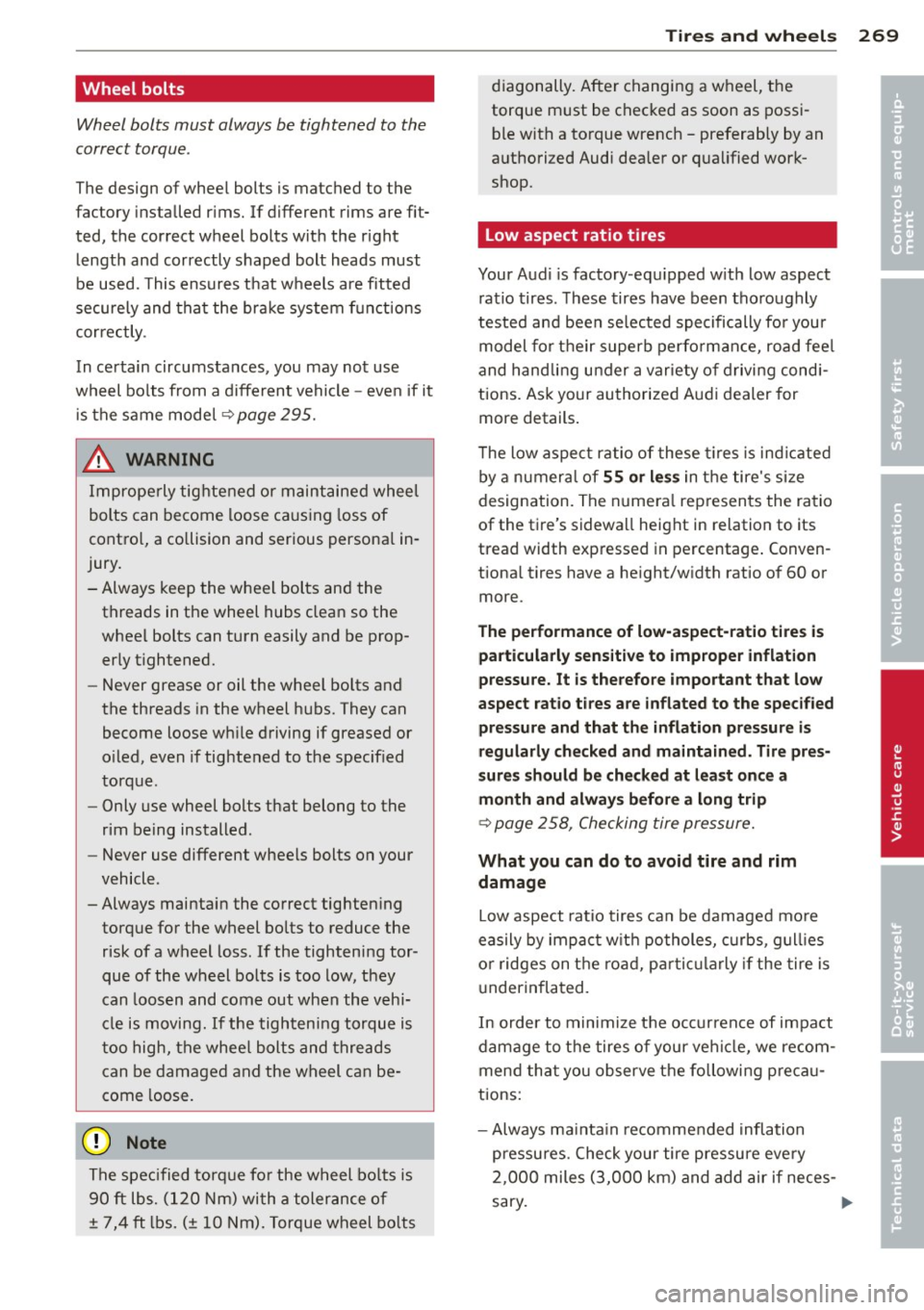
Wheel bolts
Wheel bolts must always be tightened to the
correct torque .
The design of wheel bolts is matched to the
factory installed r ims. If differen t rims are fit
ted, the correct wheel bolts with the right l ength and correctly shaped bolt heads must
be used. This ensures that wheels are fitted
securely and that the brake system functions
correctly .
In certain circumstances, you may not use
wheel bo lts from a different vehicle -eve n if it
i s the same model
¢ page 295.
_&. WARNING
Improperly tig htened or maintained whee l
bolts can become loose ca using loss of
contro l, a co llision and serious persona l in
jury.
- Always keep the wheel bolts and the threads in the wheel hubs clean so the
whee l bolts can turn easily and be prop
erly t ightened.
- Never grease or oil the wheel bo lts and
the threads in the wheel hubs. They can become loose wh ile driving if greased or
o iled, even if tightened to the specif ied
torque .
- Only use wheel bolts that belong to the
rim being installed.
- Never use different whee ls bolts on your
vehicle .
-Always maintain the correct tighten ing
torque for the wheel bo lts to reduce the
risk of a wheel loss . If the tightening tor
que of the wheel bolts is too low, they
can loosen and come out when the vehi
cl e is moving.
If the tightening torque is
too high, the whee l bolts and threads
can be damaged and the wheel can be
come loose.
Q;) Note
The spec ified torque fo r the wheel bo lts is
90 ft lbs. (120 Nm) with a tolerance of
± 7,4 ft lbs.(± 10 Nm). Torque wheel bo lts
Tire s an d wheel s 269
diagonally. After changing a wheel, the
torque m ust be checked as soon as possi
ble with a torque wrench -preferably by an
a uthori zed Audi dea ler or qualified work
shop.
Low aspect ratio tires
Your Aud i is factory -equ ipped w ith low aspect
ratio tires . These tires have been tho roughly
tested and been se lected specifically fo r your
model for their superb perfo rmance, road fee l
and hand ling under a var iety o f driving cond i
tions. Ask your authorized Audi dealer for
more details .
T he low aspect ratio of these t ires is ind icated
by a numeral of
55 or l ess in the tire's s ize
designation. The numera l rep resents the ra tio
of the tire's sidewa ll height in relation to its
tread width expressed in percentage . Conven
tiona l tires have a he ight/w idth ratio of 60 or
more.
T he performance of low-a spe ct- ra tio tire s is
p ar tic ul ar ly se nsi tiv e to i mprop er i nfl ation
pre ssure. It is the refo re important that low
a spect ratio t ires are inflated to the specified
pr ess ure and that th e inflation pr essur e is
r e gula rly ch ecked and maintain ed. Tir e pre s
s ure s should b e check ed at l east once a
m onth and alwa ys befo re a long trip
¢ page 258, Checking tire pressure.
What you c an do to avo id tire and rim
damage
Low aspect ratio tires can be damaged mo re
easily by impact w ith potholes, curbs, g ull ies
o r ridges on the road, pa rticularly if the tire is
u nderinflated.
In orde r to minimize the occurrence of impact
damage to the tires of your vehicle, we recom
mend that you observe the following p reca u
tions:
- Always ma inta in recommended inflation
pressu res. Check your tire pressure eve ry
2,000 miles (3,000 km) and add air if neces-
sary . .., •
•
Page 272 of 316
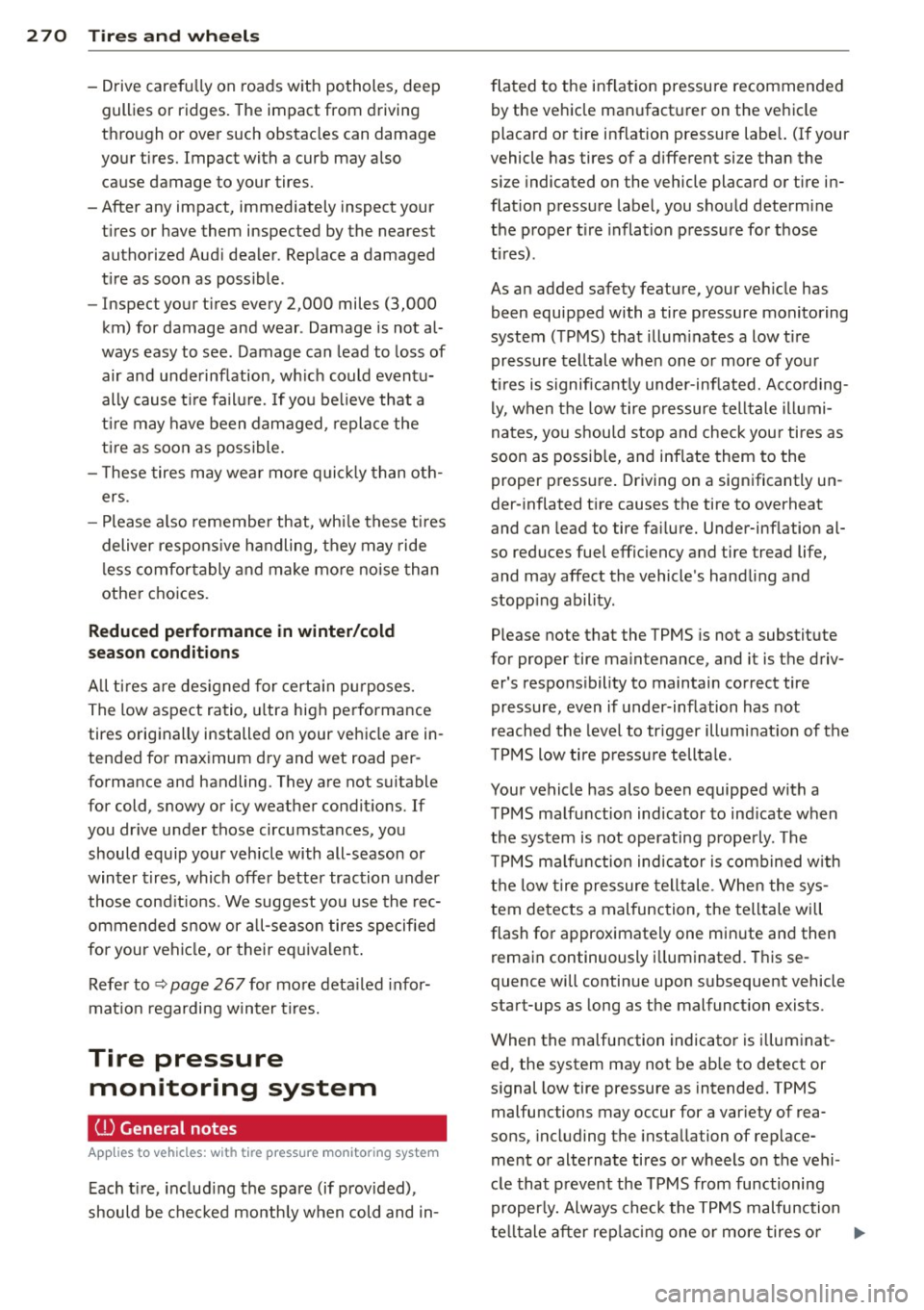
2 70 T ire s and wheel s
- Drive carefu lly on roads with potholes, deep
gullies or ridges. The impact from driving
through or over such obstacles can damage
your tires. Impact with a curb may also
cause damage to your tires.
- After any impact, immediately inspect your tires or have them inspected by the neares t
authorized Aud i dealer. Replace a damaged
t ire as soon as possible .
- Inspect your t ires every 2 ,000 miles (3,000
km) for damage and wear . Damage is not al
ways easy to see . Damage can lead to loss of
air and underinflation, wh ich could eventu
ally cause t ire failu re. If you be lieve that a
t ire may have been damaged, replace the
t ire as soon as poss ible.
- T hese tires may wea r more quick ly than oth
ers.
- Please also remember that, whi le these t ires
deliver respons ive handling, they may ride
less comfortably and make mo re no ise than
othe r choices.
Reduced perf ormance in winter /cold
sea son condit ion s
All ti res are des igned for certa in pu rposes.
The low aspect ratio, u ltra high performance
tires originally installed on your vehicle are in
tended for max imum dry and wet road per
formance and handling . They are not suitable
for cold, snowy or icy weather condit ions. If
you dr ive under those circumstances, you
should equip your vehicle with all-season or
winter tires, which offer better traction under
those cond it ions . We suggest you use the rec
ommended snow or all-season tires specified
for your vehicle, or their equ ivalent .
Refe r to ~
page 267 for more deta iled infor
ma tion regarding w inter tires.
Tire pressure
monitoring system
(l) General notes
App lies to vehicles: with tire pressure monitoring system
Each tire , includ ing the spare (if provided),
should be checked month ly when cold and in- flated to the inflation pressure recommended
by the vehicle manufact urer on the vehicle
placard or tire inflation pressure labe l. (If your
vehicle has tires of a different si ze than the
s ize indicated on the vehicle placard or tire in
flat io n pressure labe l, you shou ld determine
the proper t ire inflation pressu re for those
tires) .
As an added safety feature, your veh icle has
been equipped with a tire pressure monitoring
system ( TPMS) that illum inates a low tire
pressure te lltale when one or more of your
t ir es is significantly under-inflated. Acco rding
ly, when the low tire pressure telltale i llumi
nates, yo u shou ld stop and check your tires as
soon as possib le, and inflate them to the
proper pressure . Driving on a significantly un
der- inflated t ire causes the tire to overheat
and can lead to tire fa ilure. Under-inflation al
so reduces fuel effic iency and tire tread life,
and may affect the vehicle's hand ling and
stopp ing ability .
Please note that the TPMS is not a substitute
for proper tire ma intenance, and it is the driv
er 's respons ibility to maintain correct tire
pressure, even if under-inflation has not
reached the level to tr igger illum inat ion of the
T PMS low tire p ressu re tellta le.
Your vehicle has also been equipped with a
T PMS malfunction ind icator to ind icate when
the system is not operating prope rly . T he
T PMS ma lfunction indicator is combined w ith
t h e low tire pressure te lltale . When the sys
tem detects a malfunction , the telltale will
flash for approximately one min ute and then
remain continuously illuminated. This se
quence will continue upon subsequent vehicle
start-ups as long as the malfunct ion exists .
When the malfunction indicator is illuminat ed , the system may not be ab le to detect or
s ignal low tire pressure as intended. TPMS
malfunctions may occur for a var iety of rea
sons, including the installa tion of replace
ment o r alternate tires or wheels on the vehi
cle that p revent the TPMS from functioning
properly. Always check the TPMS malfunction
te lltale a fter rep lacing o ne or more tires o r .,.
Page 273 of 316

wheels on your vehicle to ensure that the re
p lacement or a lternate tires and wheels allow
the TPMS to continue to function properly .
Tire pressure indicator appears
Appl ies to vehicles: w ith t ire pressure monitoring sys te m
The tire pressure indicator in the instrument
cluster informs you if the tire pressure is too
low or if there is a system malfunction.
Fig . 2 15 Display: underin flati on wa rning
Fig. 216 Disp lay: System malfunction
Using the ABS sensors, the tire pressure moni
tor ing system compares the t ire tread circum
fe rence and vibration characteristics of the in
d iv idual tires.
If t he pressure decreases in one
or mo re tires, th is is indica ted in the instru
men t clus ter with a
[I] warning symbo l and a
message ¢
fig. 215. The driver message in the
disp lay goes out after 5 seconds . The drive r
message can be d isplayed again by pressing
the
! SET ! button. If only one tire is affected,
the display will indicate its pos ition.
The tire press ure monitoring system must be
reset via radio o r MM! * each time the p res
sures are adjusted (e.g . when sw itching be
tween partial and full load pressure) or after
changing or replacing a t ire on your vehicle
<::> page 2 72 . You can find the recommended
Tires and wheels 2 71
tire p ressu res for your vehicle on the label on
drive r's side B-pillar
c!;> page 256 .
Tire tread circumference and vibrat ion charac
teris tics can change and cause a tire pressure
warning if:
- t he t ire p ress ure in one or mo re tires is too
low,
- t he tir e has s tructural damage,
- the t ire pressu re was changed, w heels rotat-
ed or rep laced but the TPMS was not reset
c::>page272 .
Warning symbols
[I] Loss of pressure in at least one tire c::> .&. .
Check the tire or tires and replace or repa ir if
necessary . T he
[I] indicator l ight in the instru
ment cluster also illum inates
<::> page 13.
Check/cor rect the p ress ures of all fou r tir es
and reset TPMS via radio o r M MI*.
11@1@1 (Ti re Pressure Monito ring System) Tire
pre ssure! Sy stem ma lfunction .
Ifll@lf:1 appears after switching the ignition
on or while driving
c::> fig . 216 and the [I] indi
cator light in the instr ument cluster blinks for
approximately one m inute and then stays on,
there is a system malfunction. See your au
thorized Aud i de aler as soon as possible .
& WARNING ~
- If the tire pressure ind icator appears in
the instrument cluster display, one or more of your tires is significant ly unde r
inflated. Reduce your speed immediately
and avoid any hard steering or b raking
maneuvers. Stop as soon as possib le and
check the tires and their pressures . In
flate the tire pressure to the prope r pres
sure as indica ted o n the v ehicl e's tire
p ressu re labe l
c::>page 256. Driving on a
sig nifican tly un der- infla te d tire causes
the t ire to ove rheat and can lead to ti re
fa ilu re . Unde r-inflation also is l ikely to
impair the vehicle's hand ling and stop
ping ability .
Page 274 of 316
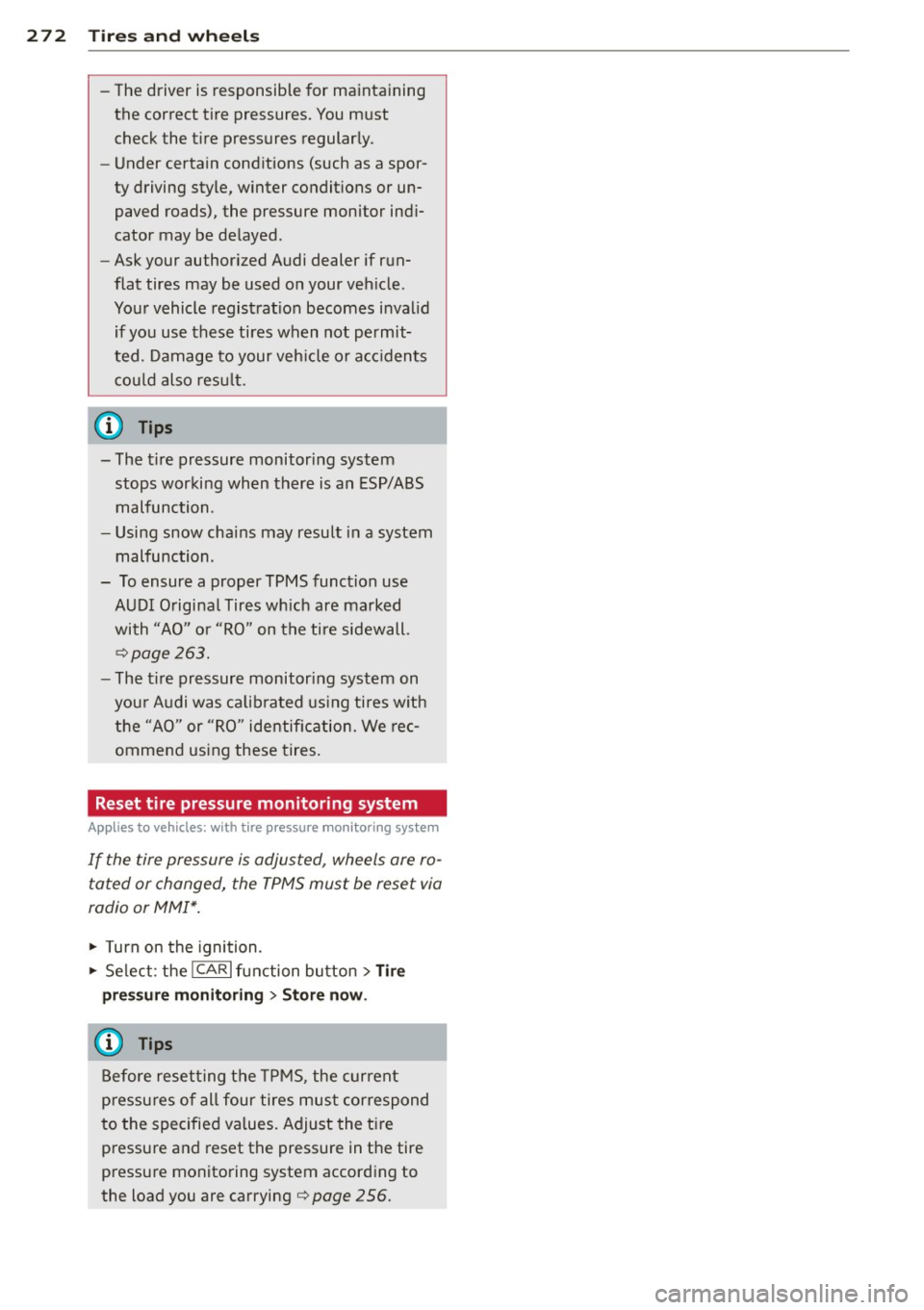
272 T ire s and wheel s
- The driver is responsible for maintaining
the correct tire pressures. You must
check the tire pressures regularly.
- Under certain conditions (such as a spor
ty driving style, winter condit ions or un
paved roads), the pressure monitor ind i
cator may be delayed .
- Ask your author ized Audi dealer if run
flat tires may be used on your veh icle.
Your vehicle regist rat ion becomes invalid
if you use these tires when not permit
ted. Damage to your veh icle or acc idents
cou ld also resu lt.
(D Tips
- The tire pressure monitoring system
stops working when there is an ESP/ABS malfunction.
- Using snow chains may result in a system
malfunction.
- To ensure a proper TPMS function use AUDI O riginal Tires wh ich are marked
with "AO" or "RO" on the tire sidewall.
¢page 263.
-The tire pressure monitoring system on
you r A udi was ca lib rated us ing tires w ith
the "AO" or "RO" identification. We rec
ommend using these tires .
Reset tire pressure monitoring system
Applies to vehicles: with tire pressure monito ring system
If the tire pressure is adjusted, wheels are ro
tated or changed, the TPMS must be reset via
radio or MM!*.
• Turn on the ignition.
• Se lect : the
ICARI function bu tton> Tire
pre ssure monitoring
> Store now .
@ Tips
Before resetting the TPMS, the current
pressu res of all four tires must correspond
to the specified values. Adjust the t ire
pressure and reset the pressure in the tire
pressu re monitoring system according to
the load you are carrying
¢ page 256 .
Page 275 of 316
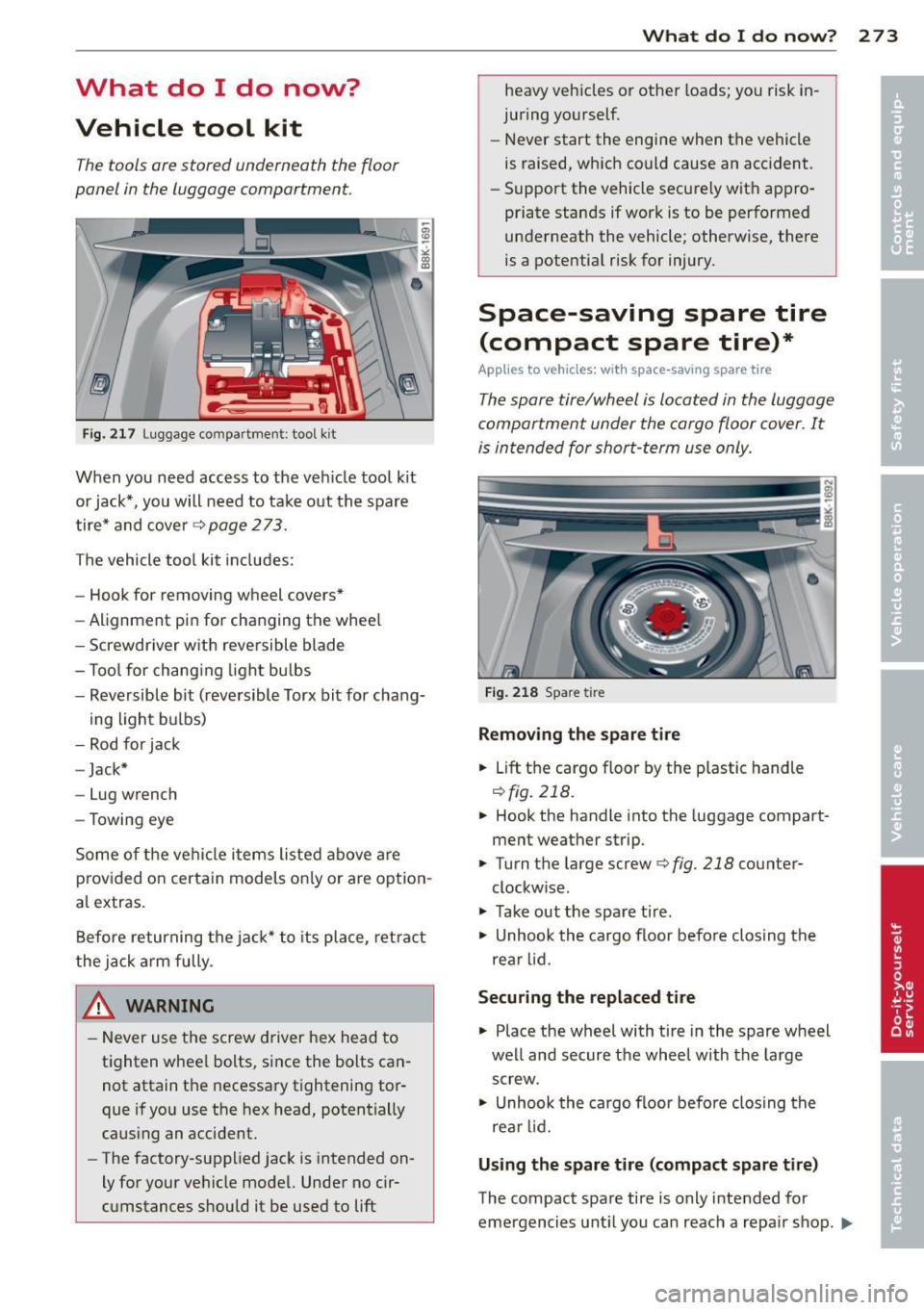
What do I do now?
Vehicle tool kit
The tools ore stored underneath the floor
panel in the luggage comportment.
F ig . 2 17 Lug gage compar tment: tool kit
When you need access to the veh icle tool kit
or jack*, you will need to take o ut the spare
tire* and cover¢
page 2 73.
The vehicle tool kit includes:
- Hook for removing wheel covers*
- Alignment pin for changing the whee l
- Screwdriver w ith reversible blade
- T ool for chang ing light bulbs
- Reversible bit (reve rsible Torx bit for chang-
ing light b ulbs)
- Rod for jack
- Jack*
- Lug wrench
- Towing eye
Some o f the ve hicle items listed above are
p rov ided o n certain models on ly or are opt ion
a l extras.
Before returning the ja ck* to its place, ret ract
the jack a rm fully.
& WARNING
- Never use t he screw driver hex head to
tighten whee l bolts, since the bolts can
not attain the necessary tightening tor
que if yo u use the hex head, potentially
caus ing an accident.
- The factory-supplied jack is intended on
ly for your ve hicle model. Unde r no cir
c u mstances should it be used to
lift
What do I d o now ? 273
heavy ve hicles o r other loads; yo u risk in
juring yo urself.
- Never start the engi ne when the vehicle
is raised, which could cause an acc ident.
- Support the vehicle secu re ly wit h app ro
priate stands if wor k is to be performed
underneath the vehicle; otherwise, there
is a pote ntia l risk for injury .
Space-saving spare tire
(compact spare tire)*
App lies to vehicles: wit h space-saving spare tire
The spore tire/wheel is located in the luggage
comportment under the cargo floor cover. It
is in tended for short -term use only.
Fi g. 2 18 Spa re tire
Removing the spare ti re
.. Lift
th e cargo floo r by the p lastic handle
r:!) fig. 218.
.. Hook the handle into the luggage compart
ment weather strip.
.. Turn t he large screw¢
fig. 218 counter
clockw ise .
.. Take out the spare tire .
.. Unhook the cargo floor befo re clos ing the
re ar l id.
Securing the repl aced tire
.. Place the wheel with tire in the spare wheel
we ll and secure the wheel with the large
screw.
.. Unhook the cargo floor befo re closing t he
re ar lid .
Using the spare tire (compact spare tire)
The compact spa re tire is only i ntended for
emergencies unt il you ca n reach a repa ir shop .
l)JI,
Page 276 of 316
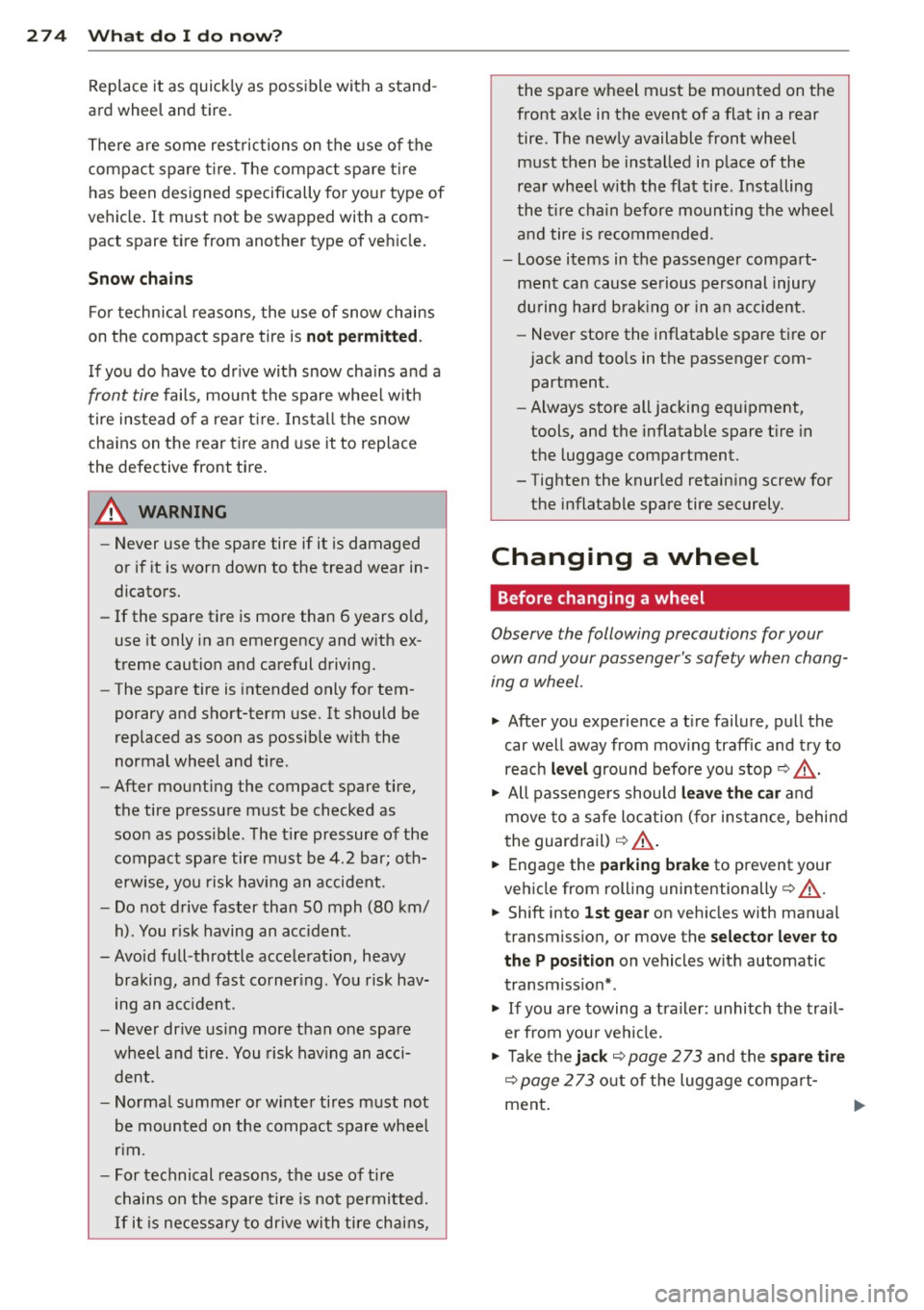
274 What do I do no w?
Replace it as quickly as possible with a stand
ard whee l and tir e.
There are some restric tions on the use of the
compact spare t ire . T he compact spare t ire
has been designed specifically fo r you r type of
vehicle . It must not be swapp ed with a com
pact spare t ire from another type of veh icle .
Snow cha in s
For technical reasons, the use of snow chains
on the compact spare tire is
not p ermitt ed .
If you do have to dr ive with snow cha ins and a
front tire fails, mount the spare wheel w ith
tire instead of a rear t ire. Install the snow
cha ins on the rear t ire and use it to rep lace
the defective front tire .
A WARNING
-Never use the spare tire if it is damaged
or if it is worn down to the tread wear in
dicators.
- If the spare tire is more than 6 years o ld,
use it only in an emergency and w ith ex
treme caution and careful driving.
- The spare tire is intended only for tem
porary and short-term use. It should be
replaced as soon as possib le w ith the
normal wheel and t ire .
- After mounting the compact spare tire,
the tire pressure must be checked as
soon as poss ible. The tire pressure of the
compact spare tire must be 4 .2 bar; oth
erwise, you risk hav ing an accident.
- Do not drive faster than SO mph (80 km/
h) . You risk having an acc ident .
-Avoid full-throttle acce le rat ion, heavy
braking, and fast corner ing . You risk hav
ing an acc ident.
- Never drive us ing more than one spare
wheel and tire . You risk having an acci
dent .
- Normal summer or winte r tires must not
be mounted on the compact spare whee l
rim.
- For technical reasons, the use of tire
chains on the spare tire is not permitted.
If it is necessary to dr ive with tire chains, the spare wheel must be mounted on the
front ax le in the event of a flat in a rear
tire. The new ly available front wheel
must then be installed in place of the
rea r whee l w ith the flat tire . Installing
the t ire cha in before mounting the whee l
and tire is recomme nded .
- Loose items in the passenger compa rt
ment can cause se rious personal injury
du ring hard bra king or in a n accident.
- Never store the inflatable spare ti re or
jack and too ls in the passenger com
partment.
- Always store all jacking equipment,
tools, and the inflatable spare t ire in
the luggage compartment.
-Tighten the knurled retaining screw for the inflatable spare tire securely .
Changing a wheel
· Before changing a wheel
Observe the following precautions for your
own and your passenger's safety when chang
ing a wheel.
" After you experience a t ire failure, pull the
car well away from mov ing traffic and try to
reach
l evel ground before you stop ¢ A_.
" All passengers should leave th e car and
move to a safe location ( for ins tance, behind
t he guardrail) ¢&_ .
" Engage the
pa rking brake to prevent your
vehicle from rolling unintentionally¢&_ .
" Shift into
1st gear on veh icles with manual
transmiss ion, or move the
selector leve r to
the P posit ion
on vehicles w it h automatic
transmiss io n*.
" If you are towing a trailer : unhitch the trail
er from you r vehicle.
" Take the
ja ck ¢ page 2 73 and the spare tire
¢ page 2 73 o ut o f the luggage compart
ment .
Page 277 of 316
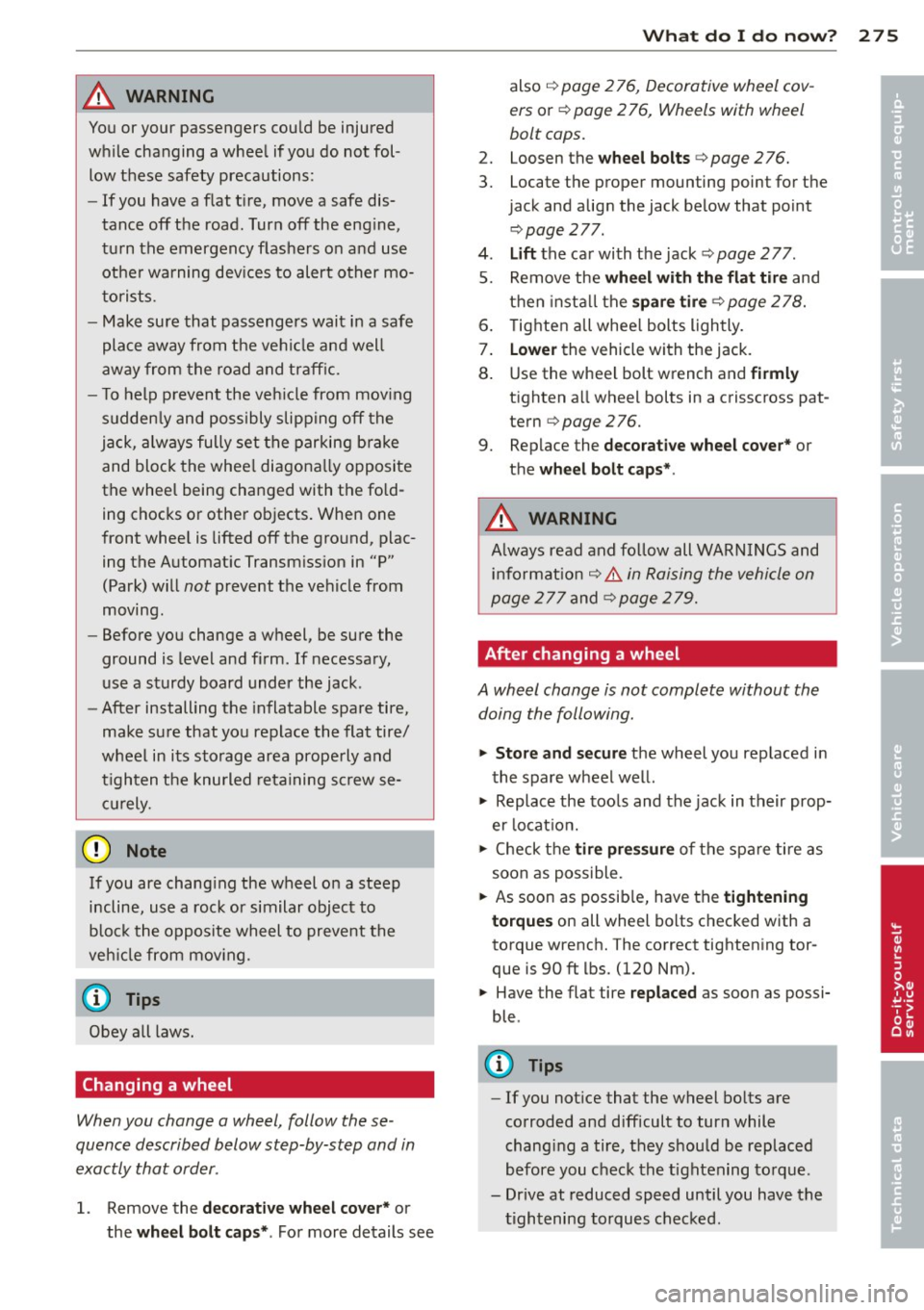
A WARNING ,~ -
You or your passengers could be injured
while changing a wheel if you do not fol
low these safety precautions:
- If you have a flat tire, move a safe dis
tance off the road. Turn off the engine,
turn the emergency flashers on and use
other warning devices to alert other mo
torists.
- Make sure that passengers wait in a safe
place away from the vehicle and well
away from the road and traffic.
- To help prevent the vehicle from moving
suddenly and possibly slipping off the
jack, always fully set the parking brake
and block the wheel diagonally opposite
the wheel being changed with the fold
ing chocks or other objects. When one
front wheel is lifted off the ground, plac
ing the Automatic Transmission in "P"
(Park) will
not prevent the vehicle from
moving .
- Before you change a wheel, be sure the
ground is level and firm. If necessary,
use a sturdy board under the jack.
- After installing the inflatable spare tire,
make sure that you replace the flat tire/
wheel in its storage area properly and
tighten the knurled retaining screw se
curely.
0 Note
If you are changing the wheel on a steep
incline, use a rock or similar object to
block the opposite wheel to prevent the
vehicle from moving.
(D Tips
Obey all laws.
Changing a wheel
When you change a wheel, follow these
quence described below step-by-step and in
exactly that order .
1. Remove the decorative wheel cover* or
the
wheel bolt caps* . For more details see
What do I do now? 275
also ~ page 2 76, Decorative wheel cov
ers
or ¢ page 2 76, Wheels with wheel
bolt caps.
2. Loosen the wheel bolts ¢ page 276.
3. Locate the proper mounting point for the
jack and align the jack below that point
¢page 277 .
4.
Lift the car with the jack ¢ page 2 77.
5. Remove the
wheel with the flat tire and
then install the
spare tire ¢page 278.
6. Tighten all wheel bolts lightly.
7.
Lower the vehicle with the jack.
8. Use the wheel bolt wrench and
firmly
tighten all wheel bolts in a crisscross pat
tern ¢
page 2 76.
9. Replace the
decorative wheel cover* or
the
wheel bolt caps* .
A WARNING
Always read and follow all WARNINGS and
information ~.&.
in Raising the vehicle on
page
277 and ¢page 279.
After changing a wheel
A wheel change is not complete without the
doing the following.
"' Store and secure the wheel you replaced in
the spare wheel well.
"' Replace the tools and the jack in their prop
er location.
"' Check the
tire pressure of the spare tire as
soon as possible.
"' As soon as possible, have the
tightening
torques
on all wheel bolts checked with a
torque wrench. The correct tightening tor
que is 90 ft lbs. (120 Nm).
"' Have the flat tire
replaced as soon as possi
ble.
(D Tips
- If you notice that the wheel bolts are
corroded and difficult to turn while
changing a tire, they should be replaced
before you check the tightening torque .
- Drive at reduced speed until you have the
tightening torques checked. •
•
Page 278 of 316
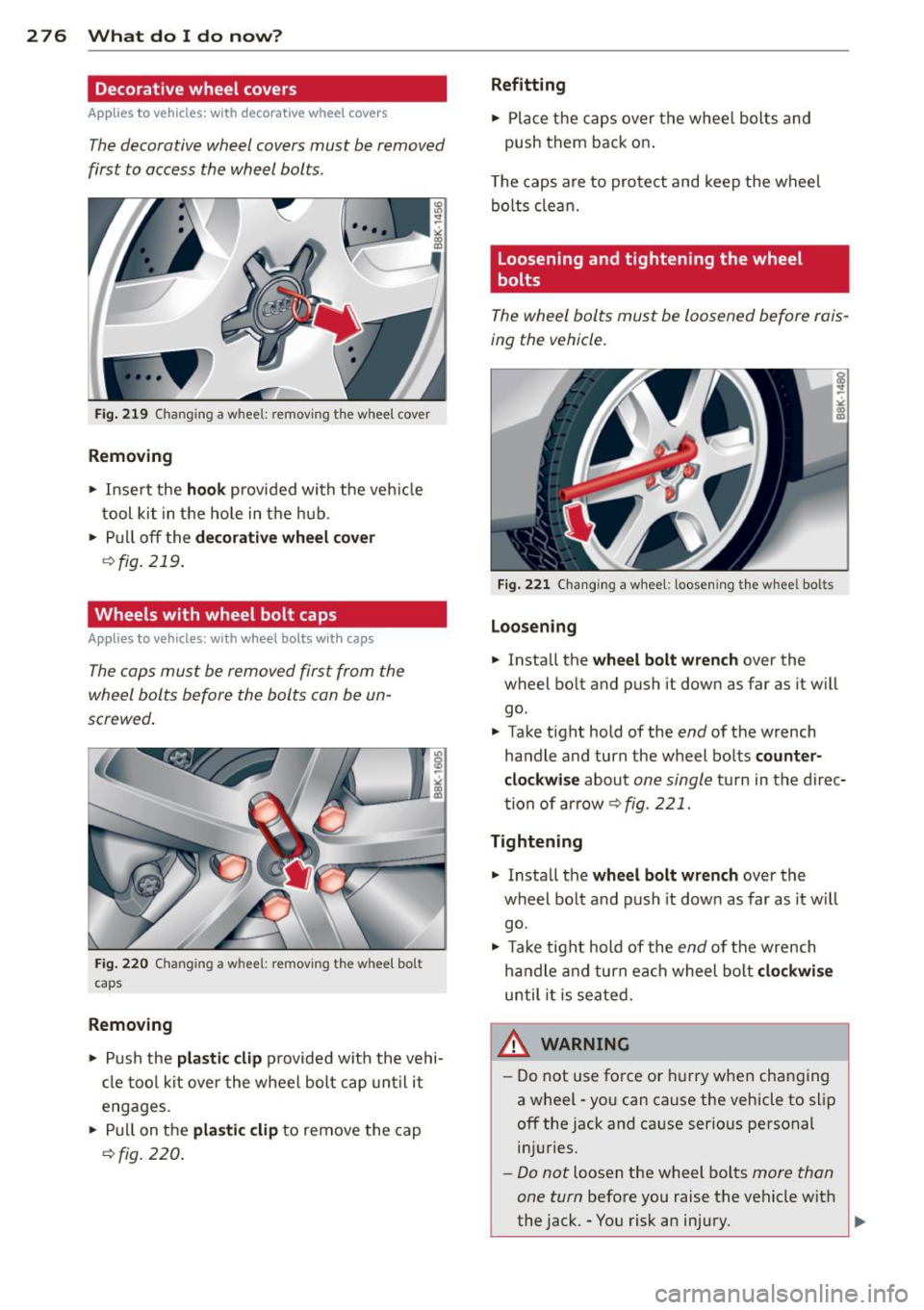
276 What do I do now?
Decorative wheel covers
Applies to vehicles: with decorative wheel covers
The decorative wheel covers must be removed
first to access the wheel bolts .
Fig. 219 Changing a w heel: remov ing the wheel cover
Removing
.. Insert the hook provided with the veh icle
tool kit in the hole in the hub .
.. Pull off the
decorative wheel cover
~fig. 219.
Wheels with wheel bolt caps
Applies to vehicles: with wheel bolts w ith caps
The caps must be removed first from the
wheel bolts before the bolts con be un
screwed .
Fig. 220 Chang ing a w hee l: remov ing the w heel bo lt
c aps
Removing
.. Push the plastic clip provided with the vehi
cl e too l kit over the wheel bolt cap until it
engages.
.. Pull on the
plastic clip to remove the cap
9fig . 220.
Refitting
.. Place the caps over the whee l bolts and
push them back on .
T he caps are to protect and keep the wheel
bolts clean.
Loosening and tightening the wheel
bolts
The wheel bolts must be loosened before rais
ing the vehicle.
Fig. 221 Changing a wheel: loosening the w hee l bo lts
Loosening
.. Insta ll the wheel bolt wrench over the
wheel bolt and push it down as far as it w ill
go.
.. Take tight hold of the
end of the wrench
handle and turn the wheel bolts
counter
clockwise
about one single turn in the direc
tion of arrow
c;, fig. 221.
Tightening
.. Install the wheel bolt wrench over the
wheel bolt and push it dow n as far as it will
go .
.. Take tight hold of the
end of the wrench
handle and turn ea ch wheel bolt
clockwise
until it is seated.
,&_ WARNING
-= -
- Do not use force or hurry when changing
a wheel -you can cause the vehicle to slip
off the jack and cause serious personal
injuries.
- Do not loosen the wheel bolts more than
one turn
before you raise the vehicle with
the jack. -You risk an injury. ..,.
Page 279 of 316
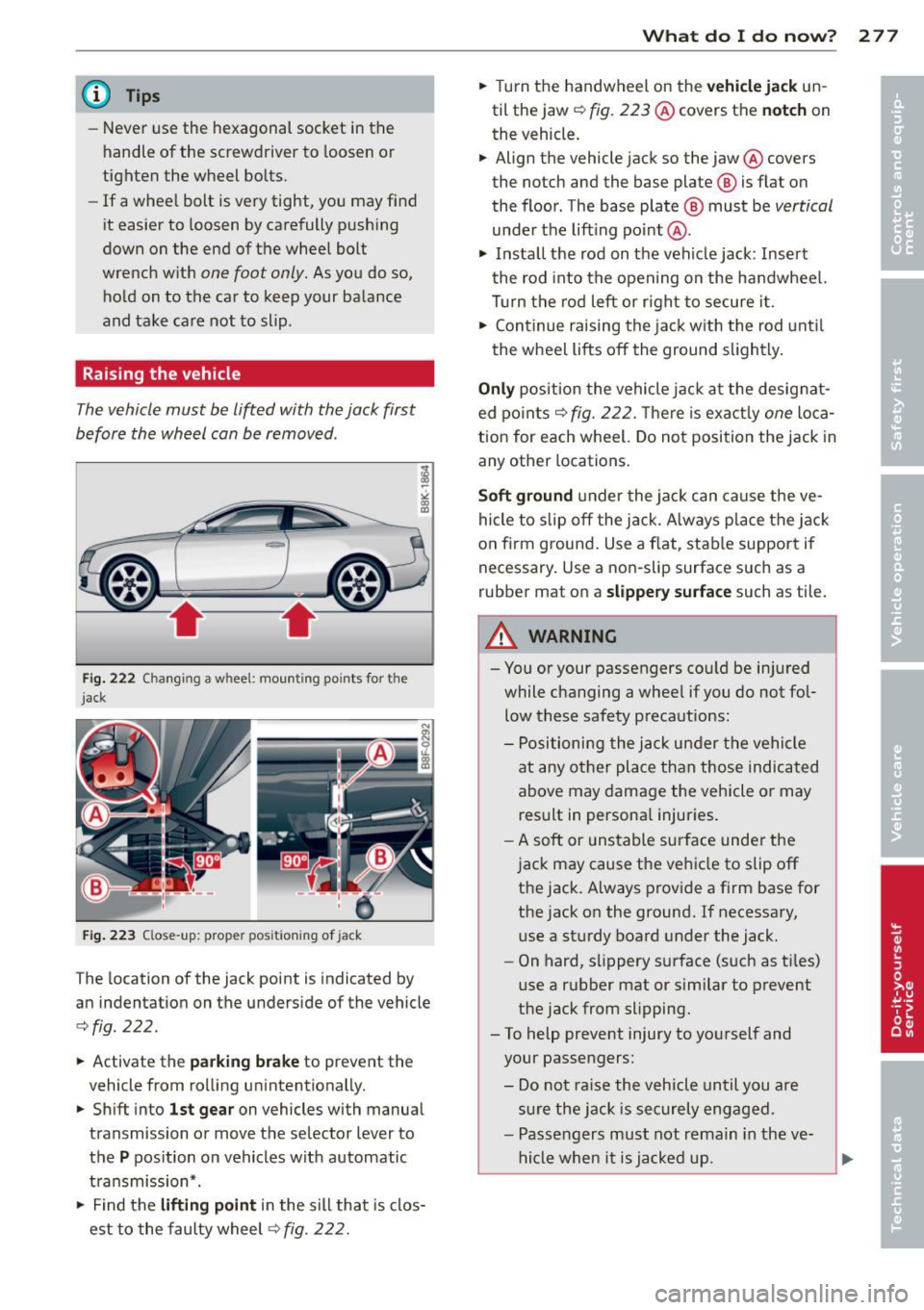
@ Tips
-Never use the hexagonal socket in the
handle of the screwdriver to loosen or
tighten the wheel bolts.
- If a whee l bolt is very tight, you may find
it easier to loosen by carefully pushing
down on the end of the wheel bolt
wrench with
one foot only. As you do so,
hold on to the car to keep your balance
and take ca re not to slip.
Raising the vehicle
The vehicle must be li~ed with the jack first
before the wheel can be removed .
*
Fig. 2 22 Changing a whee l: moun ting po ints for the
jack
F ig . 223 C lose -up: proper positioning of jack
The location of the jack point is indicated by
an indentation on the underside of the vehicle
¢ fig. 222 .
.. Activate the parking b rake to prevent the
vehicle from rolling unintentionally.
.. Shi ft into
1st gea r on vehicles with manual
transmission or move the selector lever to
the
P pos ition on vehicles with automatic
t ransmission* .
.,. Find the
liftin g point in the sill that is clos
est to the faulty wheel~
fig. 222.
What do I d o now ? 277
.. Turn the handwheel on the ve hicl e jac k un
til the jaw
c::, fig. 223@covers the not ch on
the vehicle.
.. Align the vehicle jack so the jaw @covers
the notch and the base plate ® is flat on
the floor. The base plate
@ must be vertical
under the lift ing po int @ .
.,. Insta ll the rod on the vehicle jack: Inse rt
the rod into the opening on the handwheel.
Turn the rod left or r ight to secure i t.
.. Continue raising the jac k w ith the rod unti l
the wheel lifts off the ground slightly.
O nly pos ition the vehicle jack at the designat
ed po ints
c::, fig. 222. T here is exactly one loca
tion for each wheel. Do not position the jack in
any other locations .
Soft ground under the jack can cause the ve
hicle to slip off the jack. A lways place the jack
on f irm ground . Use a flat, stab le support if
necessary. Use a non-slip surface such as a
rubber mat on a
s lippery surface such as tile.
A WARNING
- You or your passengers cou ld be in jured
while changing a wheel if you do not fol
low these safety precautions:
- Positioning the jack un der the vehicle
at any other place than those indicated
above may damage the vehicle or may result in persona l injuries .
- A soft or unstable surf ace under the
jac k may cause the veh icle to slip off
the jack. Always prov ide a f irm base for
the jack on the ground. If necessary,
use a sturdy board under the jack.
- On hard, slippery surface (such as ti les)
use a rubber mat or similar to prevent
the jack from slipping.
- To help prevent injury to yourself and
your passengers:
- Do not ra ise the vehicle until you are
s u re the jack is securely engaged .
- Passengers must not remain in the ve
h icle when it is ja cked up.
Page 280 of 316

278 What do I do now ?
-Make sure that passengers wait in a
safe p lace away from the vehicle and
well away from the road and t raffic.
- Make sure jack position is correct , ad
just as necessary and then continue to ra ise the jack.
Taking the wheel off/installing the spare
tire
Follow these instructions step-by-step for
changing the wheel.
F ig . 224 Changing a whee l: usi ng the screwdrive r ha n
dle (with th e blade removed} to turn th e bo lts
Fi g. 225 Changing a whee l: a lignm en t pi n insid e t he
top hole
Afte r you have loosened a ll wheel bolts and
r a ised the veh icle off the ground, remove and
r eplace the wheel as follows:
Removing the wheel
" Remove the topmost wheel bo lt completely
with the
hexagonal socket in the screwdr iv
er hand le (vehicle tool kit)
~ fig. 224 and
set it as ide o n a
clean surface.
" Screw t he thre aded end of the
alignment
pin
from the too l ki t hand -tig ht into the
empty bolt hole ~
fig. 225.
" Then remove the other wheel bo lts as de
scribed above. "
Take off the whee l leaving the a lignment
pin in the bolt hole
~CD .
Putting on the inflatable spare tire
" Push the spa re tire over the alignmen t pin.
" Scr ew on t he wheel bolts an d tig hten them
slightly u sing t he hexagona l socket .
" Remove the a lignment pin and insert and
tighten the rema ining wheel bolt slightly
like the rest.
" Turn the jack hand le counter-clockwise to
lower the vehicle until the jack is fully re
leased .
" Use the wheel bo lt wrench to tighten all
wheel bo lts firm ly
~page 276. Tighten
t hem
in a criss cross pattern, from one bolt
to the ( approxim ate ly) opposite one, to keep
t he whee l cen tered .
" Perform the steps required after c hangin g
the whee l~
page 275, After changing a
wheel.
T he hexagonal socket ma kes it easie r to re
move t he whee l bolts from the rim . Care
sho uld be taken when removing the reversible
blade .
(D Note
When removi ng or insta lling the whee l,
the r im cou ld hit the b rake r oto r and dam
age the rotor. Work caref ully and have a
second pe rson to help you.
(@ Tips
- Wh en mount ing tires w ith unidirectional
tread design
make sure the tread pat
tern is po inted the right way
~ page 279.
-The wheel bolts s hou ld be clean and easy
to turn. Check for dirt and corrosion on
the mating surfaces of both the w heel
and the hub. Remove all d irt fro m these
surfaces be fo re remounting th e whee l.
- Do not use the he xagonal socket in the
sc rewd river handl e to loosen or t ight en
t he whee l b olt s.